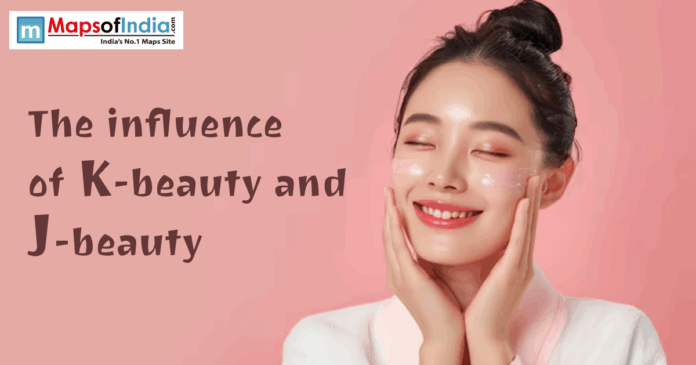The asian beauty trends have taken the world by storm over the past two decades. The beauty standards set by this industry, like Korean Beauty from South Korea and J Beauty from Japan, are reshaping the skincare and cosmetic industries across the world. The philosophies, products, and routines set by these countries have influenced people across the world about how we approach self-care and beauty standards. Both movements in these two countries have become global forces. But at the same time, their roots are rooted in their different traditions and cultural values. To get to know more about their influence, we were required to explore their history, practices, and impact on the beauty world.
Origins of K Beauty
The K Beauty standards start in South Korea. This country is well known for its innovation in the skincare and cosmetics industry. The beauty standards of this country have always focused on achieving radiant and youthful-looking skin. The culture in Korea is focused on one’s skin health, which is considered a sign of self-discipline and confidence in the country. The earlier traditions of beauty practised in this country, were used natural ingredients like ginseng and green tea, and these ingredients, over the period of time, evolved into modern formulations making today’s beauty products. In the rise of Korean recent years, the Korean pop culture, including K-Pop and K-dramas, has exploded all over the world, helping to spread its beauty ideals across the globe.
The K Beauty Philosophy
The philosophy of K Beauty is deeply rooted in their culture of prevention and maintenance. They believe that instead of covering one’s flaws by applying heavy makeup, they made it their goal to build healthy skin from within. To obtain this skin, skincare things, like hydration, layering of products, and gentle treatments on the skin, are done. Over time, they developed the popular 10-step beauty routine, introducing the world to the beauty processes like cleansing, toning, essence, serums, masks, and sunscreen in a single regimen. To follow this routine, you need to maintain consistency and patience. This will teach people to treat skincare as a daily necessary ritual rather than a method of a quick fix.
Popular K Beauty Products
The beauty products produced in Korea are famous for their innovative thinking. Beauty products like sheet masks became a global trend in a small time. This mask offers hydration to the face and gives the treatments to the customers in an accessible form. They developed the BB creams. Through this cream, the world got introduced to the lightweight coverage for the skin, which also had added skincare benefits. They developed a cream application device, like cushion compacts, that revolutionised how makeup is applied. In this method, the combination of foundations is used with convenience. The Korean beauty brands started to experiment with beauty products using unique ingredients like snail mucin, fermented extracts, and Centella asiatica, and these products, over time, gained international popularity.
Origins of J Beauty
The beauty process of J Beauty has a longer and more traditional history to it. These beauty standards are deeply rooted in Japanese culture, which emphasises simplicity and timeless rituals. From ancient times, Japanese women have historically used rice water, camellia oil, and seaweed in their daily skincare routines to take care of their skin. The Beauty values in Japan keep focus on minimalism, they try to use fewer products that can leave a long-term effect on the skin. On one hand, Koren Beauty gained attention through trends. The Japanese Beauty’s influence on the world comes from its reputation for product quality, reliability, and scientifically developed formulations.
The J Beauty Philosophy
The main philosophy of the Japanese beauty approach is centred around longevity and balance in beauty. This idea of beauty promotes the approach that says less is more. The typical daily routine in this beauty care includes cleansing, moisturising, and applying sun protection. This routine can be followed by using only a few carefully chosen products. These skincare rituals are important, but they are designed to be sustainable over a long time. The focus of these beauty practices is on protecting the skin barrier and maintaining harmony. Through the J Beauty practices, we can see they reflect the Japanese cultural values like simplicity, mindfulness, and respect for their tradition.
Popular J Beauty Products
Through the Japanese Beauty standards, the world got introduced to cleansing oils and the double cleansing skincare process. This skincare practice involves using an oil-based cleanser that will be followed by a water-based cleanser. This process will ensure that the skin will have deep but gentle cleansing. Lightweight lotions and emulsions became key products for hydration in their skincare process. Using repetitive sunscreen became a major strength of the Japanese beauty routine, and Japanese products also focused on it. They developed a sunscreen formula that is effective yet comfortable to wear daily. Japanese beauty products place emphasis on effectiveness and refinement rather than novelty.
K Beauty vs J Beauty Approaches
Both skincare processes share a dedication to keeping skin good for a longer time; their approaches are totally different. Korean Beauty is thriving through focusing on innovation, variety, and playful packaging. These skincare products are more appealing to a younger consumer base who are good at experimenting with new trends. The Japanese Beauty approach is more focused on following tradition, simplicity, and timeless quality. This skincare approach resonates with those who prefer stability and effectiveness over experimentation on their skin. These differences in both beauty approaches show how cultural values shape beauty philosophies. Together, they offer different kinds of approaches to skincare that can complement each other.
Challenges and Criticisms
Both Korean Beauty standards and Japanese Beauty standards have faced many challenges over time. Korean Beauty standards are often criticized for overwhelming consumers with too many steps and costly products. Over time, some trends might feel unsustainable or excessive. The Japanese Beauty standard faces the challenge in their own way, like being overshadowed by the global buzz that is happening around K Beauty. Both of these beauty movements also face the issue of cultural appropriation. Many global companies adapt their beauty ideas without honouring their original roots.
Final Thoughts
The beauty standards from both countries have become global cultural movements that reflect the values of their respective countries. The philosophies, products, and influence of these beauty standards have redefined how people around the world view skincare. Both countries focus on different values of skincare. But at the same time, both continue to inspire creativity and confidence among users. Together, these two beauty standards highlight the power of one’s culture in shaping global beauty industries and shaping personal skincare routines.





